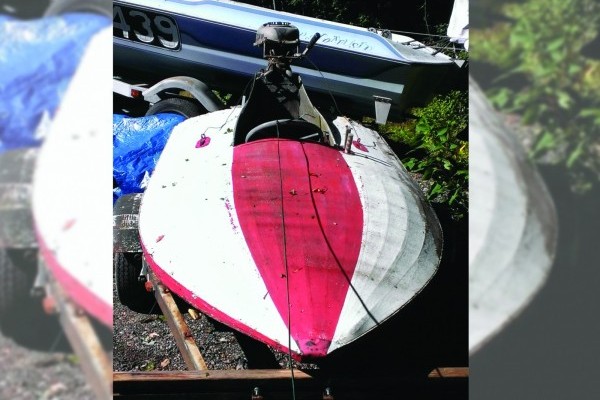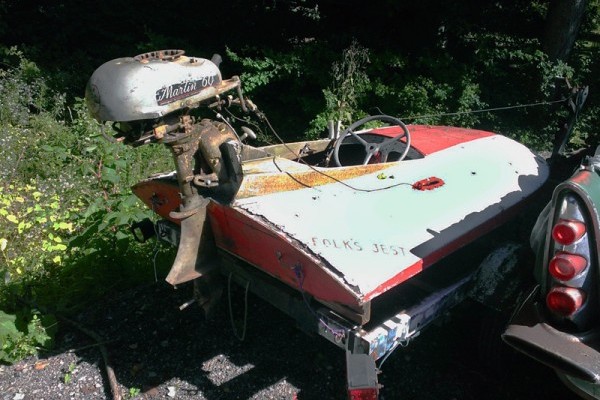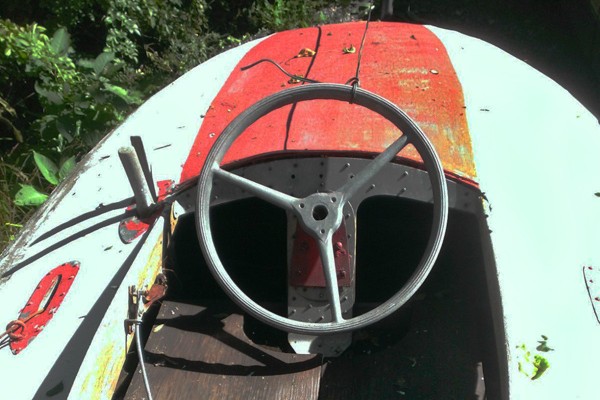Summer is almost here, at least for those of us in the upper part of the US where there is more than one season. You should be able to restore this 1940s-1950s homebuilt hydroplane boat by the time that summer fever kicks in. This former race boat is found here on eBay in Suffern, NY, about forty minutes northwest of Yonkers. The seller is asking $750 or best offer for this cool little cruiser.
Nobody knows who made this boat or exactly when it was made, but it looks like they did a good job with it. Of course, after sitting for a few years the canvas covering needs to be replaced and the wood could use refinishing, too. My neighbor restored an old, beat-up, and worthless-looking wooden canoe and it was mind-blowing how beautiful it was when it was finished. He refinished the wood and stretched new canvas over the bottom and it was better than new. His canoe was a work of art when he was done with it and I can picture this boat being in that condition. I could see this boat being a great project for a son or daughter, or for a regular ol’ adult, too.
Unfortunately, the trailer doesn’t come with the boat, but the Martin 60 outboard does. It’s not original to the boat but the seller says that this outboard was used by an APBA (American Power Boat Association) hydroplane in the 1950s.
Martin 60 outboards were only made from 1946 through 1950 so it’s an old motor and it would be another great restoration project. All kinds of parts are still available for this Martin.
The motor also comes with a racing steering bracket. Boy, this boat must really have been something when it was first built. And it could be again with a little work. Does this project boat turn your crank, or should it be dry-docked?












This boat pretty-much exemplifies just why fiberglass surplanted wood and canvas boat construction. Anyone brave enough and with enough spare time to rebuild it deserves admiration and sympathy. ;-) Luckily, the auction has already ended!
DEATHTRAP
But I want to see what’s under the cover next to it.
Exactly my thoughts when I saw the images.
Car next to the boat looks like a 57 Desoto Firesweep.
ive designed so many of these outboard powered little water speedsters in my head and on paper that it’s probably time that i built one.
i notice that the outboard is mounted on a high transom putting the propeller just below the hull – something i never considered.
this looks like fun.
Tip of the hat to Scotty G.( you BF folks did a good thing bringing him on board) This is the LAST thing I’d ever think would show up here. While the motor is clearly from the early ’50’s, I don’t think the boat itself is that old. You could buy plans for these out of Popular Mechanix, and build it yourself. It’s hey day, I believe, was the early ’60’s. They came in several shapes, and the one I drove was indeed a handful. It didn’t like rough water, but calm water, it was a blast. The motor of choice for these was the “10hp Mercury”. https://upload.wikimedia.org/wikipedia/commons/d/df/1951_Mercury_Super_10_Hurricane_Outboard_Motor.JPG
So much so, they were hard to come by. This particular boat looks a little tired ( however, I’m no carpenter, so it could be fixed) and the motor can go into a museum. The reason the motor is mounted so high on the transom, is when you slowed down, these boats had a tendency to sink in the back, swamping the motor ( found THAT out the hard way) Now if you had real “chutzpah”, you’d run a 20 Merc on these. Great find.
Howard is correct. There are plans that are probably still being sold in the back of wooden boat magazine for similar machines. I have a buddy who has one in his garage that was built by his late father in the latter part of the 70s. His is in much better shape than this and he only keeps it for sentimental reasons.
The motor is the most important item here.
I know someone who built one in the late 60s or early 70s. If he stopped the engine, it sank. He hauled it back up multiple times.
The motor is mounted high on the transom to keep as little of the lower unit in the water as possible. the water pickups have to be modded to do this, but on my Checkmate it was good for 7 or 8 miles per hour. Got it up to 73 mph once. holey chine walk.
Vintage photo from I believe the late 50s. Lake Silkworth, PA
That is a B stock runabout..Looks to have a Mercuruy Mk 20 motor (gold color) with out the lower conversion. Probably 1955/1957.. The hydro in the other photo looks to be a single step hydro used in the 1940 s and early 1950 before the 3 point hydro design took over. Hope this helps.
Another vintage photo
and one more
Denjbar – this one looks like a very small “crackerbox” to me, not a hydroplane. If it Were a hydro the numbers would be on the sponson deck, not the side. Cool photo regardless!
Not a Hydroplane , Hydroplanes have a 3 point hull design with load bearing on the 2 front sponsons this boat bears load on the rear of the hull , this boat is a mono hull
with the 6 hp motor it would run about 36 – 42 mph and would be a wild ride
i
Right, mono hull. Dad and I built an eight footer in the 70’s. We used marine plywood and fiberglass cloth covered with colored epoxy resin for finish. It was four by eight (the size of a sheet of plywood). About one inch thick in the front and four in the back. The compartments were sealed and contained flotation. We put our 7.5 HP Mercury on it, swapped in a two-blade prop. What a ride! You had to lean out on the front deck to get it to hop up on to plane. It would plow at 5 MPH, and then jump up on top of the water and surge instantly to about 30 MPH (we guessed — perhaps faster). It bounced along the top of the water and any chop at all would about knock your fillings out. It got sold when they sold the farm. Sure wish I had it today.
Nice. I had a 13′ Glasspar Balboa with a 7 HP Merc on it in about 56 – 57. Much bigger boat and much heavier, but I could get it up on a plane if I got up on the forward seat and steered with my foot. I suspect top speed at around 15 to 18 MPH of very iffy wave jumping in open ocean. I have a 1960 16′ Glasspar Citation now with a Mercury 70 HP direct-reversing Marathon that will probably do > 45 on flat water and scare the hell out of anyone not behind the wheel. My dad had a patent on the hull shape. Hydroplanes are smooth water boats, which is something we seldom see!
Yup. They were also popular with the Mechanics Illustrated crowd. They were all plywood – no canvas, and were really harsh in any kind of chop.
Matt, I love hearing about the various ways we bravely got our machines to do our bidding. You learned fast to hang on, think quickly, and feel what the vehicle wanted. My dear wife, who is not mechanically inclined, has no “engineer’s sense of machinery.” Ah reckon most everyone on this group understands. No need for any of them sissy shields, safety interlocks, and other nonsense.
I understand better than you know. ;-) My wife, who I hope never reads this, can’t relate to anything “vintage” and (oddly) only appreciates excitement-free rides in anything. I seem to have a contrary point of view on this subject – having been raised in a time when getting there at all was a big plus! I doubt that I’d risk taking her out in anything I had to steer with my foot.
Well Matt, you put a mile-wide smile on my face. Getting there is indeed the better part of the journey. And what’s wrong with the foot-steer option? Frees us up to put our arms around our dear wives.
Do you remember the old Willys that took all appendages to start:
– Left foot clutch
– Right heel gas
– Right toe starter
– Left hand choke
– Right hand ignition switch
Then in a symphony of coordination, and before the six-volt battery expired, you got it coughing, then running. I was just telling my neighor this weekend, as we struggled to get his mower started: “Its great when the motor starts!”
Exactly. My 50 Willys wagon fit your description perfectly. I lived in mortal fear of having to stop on a steep uphill grade because of the stuff you descibe – plus the almost useless parking brake! As long as you kept creeping along in low-range low gear, the thing would go almost anywhere, but taking it out for a drive up to San Francisco was unthinkable. I installed an Advanced Adaptors overdrive in mine, which gave me about 65 on the highway and 20 MPG. Never had to lock it since today’s car thieves would know how to start it. :-) I loved the the 134 F-head. I had a 52 Francis Barnett motorcycle (Villiers engine) that would occaisionally sieze-up while driving. I had to keep it rolling and bump start it before it locked up for good. Maybe I should have kept it as a vetting device for the girls I was interrested in?
Matt, you won’t believe it. I spoke of a 1950 Willys Jeepster. I have a photograph somewhere. I’ll scan and post it if I can find it.
And I concur about using the bike as a gal filter. Still, that’s pretty alarming if it would lock up while driving. You were probably very sensitive to every sound and bump wondering if impending seizure was about to occur.
You know the animal! I always wanted to put a Jeepster body on a Jeep 4X4 truck chassis – or wagon, for that matter. My wagon came with an owner’s manual that called it “a real sport – utility vehicle”. I’m sure that they’re the ones that coined the term. I have to admit to causing burn scars on the legs of a very pretty girl with the pipe on my Frannie-B. :-( Her mother was right to be sceptical of my judgement skills! I didn’t even know she’d been burned until we’d stopped somwhere on Balboa Island. No helmets, tennis shoes and shorts. It’s pretty amazing that so many kids of our generation survived at all!
Found something like this tossed away in the alley in Detroit when I was 8, back in 1970. Wooden frame and canvas covered, painted black. Looked like it had been through hell. It sat there for a month before the garbage man finally shoved it into the back of the compactor truck, crushed it, and hauled it away. It was a single step hull with the wide sponsons and narrow transom. Made a kinda nice toy for an alley-picking kid like me.